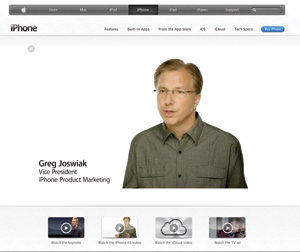While I miss Steve Jobs and whatever was next in that brilliant mind, I am very happy with his last gift, the Apple iPhone 4S. While I am very pleased with the features of the phone (more on that later), the experience all starts with the video on the company’s website, which not only tells me about the product, but also uses the AIDA formula (awareness, interest, desire and action) to motivate me to complete the purchase. The video and the website are also up-to-date examples of my concept of edu-selling: teaching people why they should buy something and teaching them how to make the best use of it so as to be satisfied with their purchase.
Now that you have probably turned the cover of the magazine or checked the website to make sure you were reading my column in SportsBusiness Journal, let me explain why I think this product and this approach are critical to sports organizations. Simply stated, Apple has become the success it is because it didn’t assume too much about the knowledge and computer skills of its potential buyers. It made its devices and applications so easy to use that the audience ranges from children to senior citizens. While there were no assumptions that anyone already knew how to use its products, Apple did make one assumption and it was correct: The easier and simpler the devices were to use, the more people would use them.
 |
| Apple uses the AIDA formula (awareness, interest, desire, action) to teach and motivate buyers. |
Let’s translate that into our sports teams at all levels, including the collegiate teams. While a few innovative teams have some introductory information on their websites, most offer some type of printed or downloadable fan guide, which is one-way communication and is not interactive or intuitive. Go to apple.com and watch the video about the phone; then log onto the website of your favorite team and see if there is a similar attempt to educate or inform. Or, are they just skipping to the sale?
Most teams offer some assistance in ticket buying by providing virtual views to show the sight lines from seats with a comparative feature that allows potential buyers to choose their preferred view. Most teams also offer all current ticket-plan holders a personal account representative to answer their questions and help them manage and enjoy their accounts. I have always been a big proponent of this system, but it has its shortcomings. First, the service is only available to current ticket-plan owners who, at least in theory, would have fewer questions than someone trying to go to a game for the first time. Second, it is not an on-demand 24/7/365 type of system, and many questions originate outside of business hours.
Contrast this with Apple’s addition of Siri on the newest phones. Siri, which Apple calls “the intelligent assistant,” can answer questions and serve as your personal assistant. So my mind began to race and imagine similar technological innovations either directly on the teams’ websites or else through an application on a portable device that had similar intelligence to Siri.
As I brainstormed, playing the part of a fan considering buying tickets to his or her first MLB game at Citi Field, my imagination created the following dialogue:
Fan: Buddy, what is the best location in terms of affordability for my family and I to purchase tickets for the Mets vs. Cardinals game next Friday?
Buddy: By “location” do you mean where to buy tickets or what seats are the most affordable?
Fan: Well, both.
Buddy: StubHub is offering a variety of ticket offerings for that game ranging from a low of $12 per person to a high of $48 per person depending upon the seating area you would select. In terms of location within the stadium, the most affordable seats in terms of price considerations only for this particular game are located in Section 501.
Fan: Thank you, Buddy. We are staying at the Marriott Hotel in Times Square. What is the most efficient and economical way of getting to Citi Field?
Buddy: You should take the No. 7 train from Times Square directly to Citi Field.
Fan: When we arrive at Citi Field, I would like to have dinner with my family, and we have two children under age 12. What concession stand would you recommend for my family?
Buddy: My recommendation would be Shake Shack, which is located in the outfield seating section near the bullpen gate. This area has several restaurants that would provide other alternatives for your family to consider, as well.
While this may seem too simple, that is why it works. The questions that someone would have about something that they have never experienced are simple and they are usually directly related to their experience, more important to them than to someone else. The issue here is the need to change our existing processes and procedures, which are convenient and easy for us (the provider), and to move to a mind-set where the goal is to provide information to the person inquiring in the easiest, most helpful format possible. That will probably require some degree of artificial intelligence to prompt and ask the question correctly, like I did when asking about where to buy/where to sit.
This is something that must be addressed immediately. “It’s not in the budget” is not the right answer when having the service could have a positive impact on the budget. Siri is in beta form, thus there are ways and means to improve the service and create applications for sports and other industries.
Find and invest in a provider that can offer the technology and the service — and not necessarily in personnel and on-site technology, as it is developing far too rapidly to really be able to strategically decide what to buy. As usual, sports is the late adapter/adopter, but it is better to be late than to be too late.
Bill Sutton (wsutton@bus.ucf.edu) is a professor and associate director of the DeVos Sport Business Management Program at the University of Central Florida and principal of Bill Sutton & Associates. Follow him on Twitter @Sutton_Impact.





